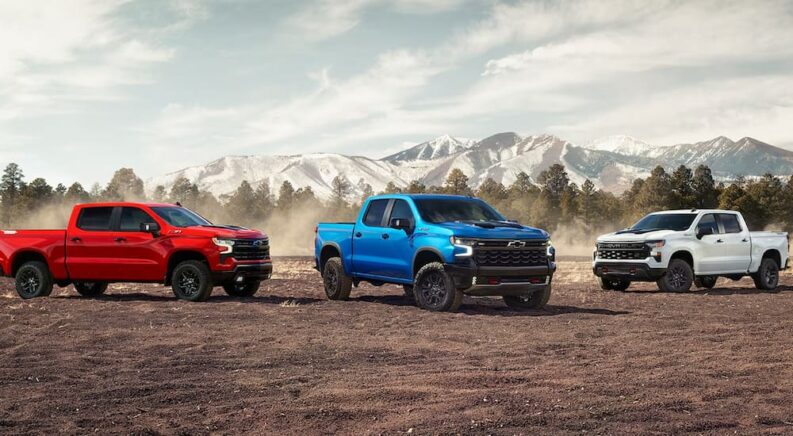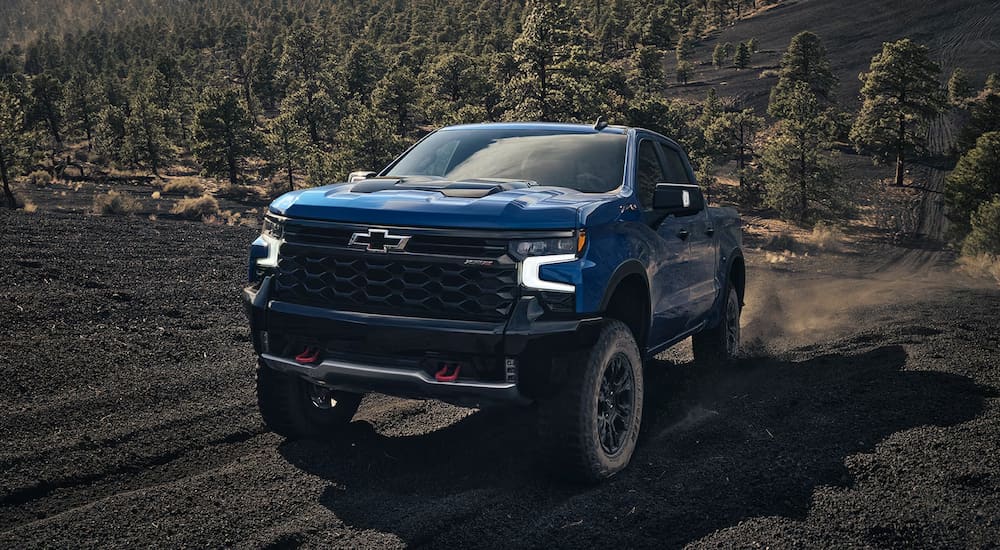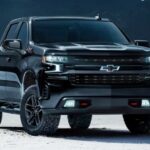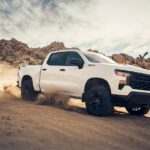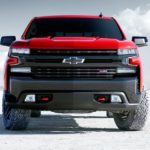The Chevy Silverado ZR2 came bursting onto the scene for the 2022 model year. It was a huge step up in terms of off-road capabilities for the Silverado when it came to competing with Ford’s Tremor and the headline-stealing Ram 1500 TRX. The 2024 Chevy Silverado 1500 still offers the ZR2 as the top-of-the-line trim, but what some people may forget is that the Silverado 1500 also has two other dedicated off-road trims available: the Custom Trail Boss and the LT Trail Boss. If you were stalking a Chevy dealer for a good deal on an off-road Silverado 1500, you might be wondering what the benefits would be of opting for the cheaper Trail Boss trims as opposed to the more expensive ZR2.
Let’s take a look at the pros and benefits of the Trail Boss, and explain what you get and why it’s important. If you’re still unfazed by the information, feel free to stick with the ZR2 as the go-to solution for your off-road Silverado 1500 antics. It’s the top trim for good reasons. However, those of you looking for something a little more within your wheelhouse might find the Trail Boss offers a good alternative to the ZR2.
What Makes the Trail Boss Off-Road Ready
We hear about the ZR2 a lot, and with good reason. It has elevated the value of the Silverado 1500 as an off-road machine. However, the Trail Boss has been around since the 2019 model year for the Chevy Silverado 1500, after initially making its debut as a trim for the Colorado in 2016. The trim is designed to provide many of the basics that you’ll need to venture off-road.
The Trail Boss comes equipped with a factory-installed two-inch lift kit, automatically providing the advantage of a taller ground clearance for off-road purposes. There’s also the inclusion of 18-inch high gloss black painted aluminum wheels paired with 32-inch mud-terrain Goodyear Wrangler Territory blackwall tires. All of the Trail Boss trims also come with the Z71 Off-Road Package, which includes a locking rear differential, skid plates, and improved shocks.
Additionally, the Trail Boss trims come with minor visual aesthetics that give them a more menacing look compared to the other trims. A rugged exterior with a two-tone vented hood and red front tow hooks help signify the trademark qualities of the Silverado’s off-road Trail Boss trims. This adds an extra sense of value to those who want their truck to look as good as it performs off-road.
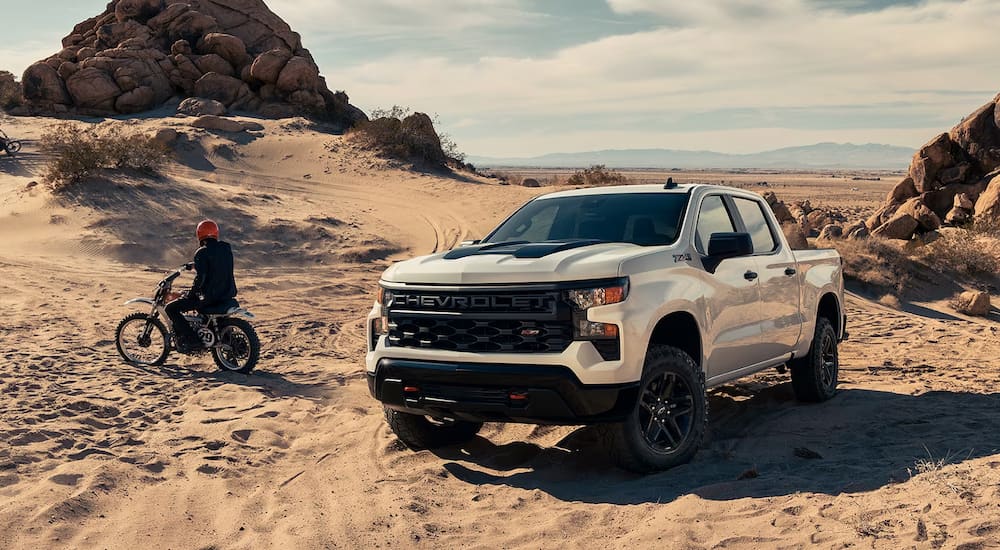
Comparing the LT Trail Boss to the Custom Trail Boss
The general feature set of the Trail Boss is enough to get you up and out on (or off) the road with ease, you might be wondering what the differences are between the two Trail Boss trims, and whether either one will satisfy that urge to jump dunes and trek through mud versus the ZR2. Both offer the basics of what you need to get the most out of the Silverado in off-roading conditions. However, they differ in terms of the equipment you get with them and whether or not that will appeal both to your sense of utility and convenience.
The most obvious difference between the Custom and LT Trail Boss trims is that the LT comes with more interior features, such as a wrapped leather steering wheel. You also get the added convenience of heated driver and front passenger seats. Some additional features include a ten-way power front driver seat with lumbar support, dual-zone automatic climate control, and an improved infotainment suite that includes a 12.3-inch digital driver display and a 13.4-inch HD digital touchscreen as part of the Chevrolet Infotainment 3 Premium System featuring Google Built-In. Finally, the LT Trail Boss unlocks the 6.2L V8 engine option, which is not available in the Custom Trail Boss.
Alternatively, with the Custom Trail Boss, you have the 3.4-inch digital driver display and seven-inch infotainment touchscreen. Otherwise, as far as functionality is concerned, the Custom Trail Boss and LT Trail Boss are both designed to provide competent, rugged, off-road travel. What may make the Custom Trail Boss more appealing is that it costs roughly $7,000 less than the comparable LT Trail Boss with the same engine.
Thanks to the factory lift kit and the improved suspension, both iterations of the Trail Boss offer slightly higher ground clearance compared to the other Silverado 1500 trims. You have up to a 10.9-inch ground clearance when configured in a Crew Cab and a short bed box, which improves approach angles and departure angles for both overlanding and enthusiast off-roading.
How the Trail Boss Stacks up Against the ZR2
The real moment of truth, however, is whether or not the Trail Boss is a suitable stand-in for the ZR2. Can you still enjoy your off-road antics if you don’t have the top-of-the-line Silverado 1500 trim? Yes, of course you can! There are some noteworthy differences between the two trims, with the most obvious being the price. Yes, there is an unabashed 25% markup between the Custom Trail Boss and the ZR2, and an approximate 17% markup between the LT Trail Boss and the ZR2. If you can move beyond the MSRP, is there anything that the Trail Boss lacks that the ZR2 does better when it comes to off-roading?
The ZR2 is named for its special ZR2 suspension package, which includes the racing-tuned Multimatic DSSV dampers. These spool valve dampers dynamically adjust to ensure you get the most stable performance out of the ZR2 regardless of the terrain. It also comes with a high-performance lift kit, multiple skid plates, an electronic transmission range selector, and 33-inch Goodyear Wrangler Territory blackwall mud-terrain tires.
If you’re willing to spend even more, there is the availability of the ZR2 Bison Edition, which comes with a few extra add-ons, such as American Expedition Vehicles-branded components. It also has unique skid plates, AEV steel boron bumpers, rocker protection, and special suspension improvements. The ZR2 Bison also has an improved ground clearance of 11.2 inches, providing 0.3 inches of additional clearance over the Trail Boss. However, even with these improvements, you are looking at a price difference of a 35% markup with the ZR2 Bison Edition over the Custom Trail Boss and a 27% markup of the ZR2 Bison over the LT Trail Boss.
Benefits of the Trail Boss Over the ZR2
You’re probably thinking, “Why not just stick with the ZR2,” but it’s not that simple. The Trail Boss still has its benefits beyond just having a lower MSRP. For instance, you have more powertrain options with both the Custom Trail Boss and the LT Trail Boss over the ZR2 and ZR2 Bison.
The Custom Trail Boss offers not only the same 3.0L Duramax turbo-diesel as a powertrain option but also the 5.3L EcoTec3 V8 and the 2.7L TurboMax I-4, neither of which are available on the ZR2. The LT Trail Boss adds the 6.2L V8 to the selection, providing all of the powertrain options of the ZR2 and the Custom Trail Boss, and the most versatility in terms of powertrain options.
Additionally, the Custom Trail Boss and LT Trail Boss also offer better towing specs over the ZR2. If you plan to use your Silverado 1500 for off-roading, racing, camping, mudding, rock crawling, or hill climbing, but you also want to use it as a work truck, the Trail Boss is much more versatile than the ZR2. The ZR2 with the 6.2L V8 tops out at 8,800 lbs of towing capacity, whereas the Custom Trail Boss and LT Trail Boss with the 6.2L max out at 9,200 lbs.
Making the 2024 Chevy Silverado 1500 Trail Boss Worthwhile
The Trail Boss trims for the 2024 Chevy Silverado 1500 may not always get the respect that they deserve. However, they offer everything that most people need to tackle many of the basic off-road adventures you can imagine. Whether you’re an avid weekend warrior or a casual off-road enthusiast, the Trail Boss trims are decent enough for the task. The suspension, rugged exterior, infotainment, tires, and design all lend themselves to being a nice off-road alternative to the top-end ZR2. At the same time, the Trail Boss is still very capable as a work truck with acceptable towing and payload specs, which is great if you want that all-in-one functionality of a stable daily driver and the ruggedness of an off-road truck. All this makes both Trail Boss trims a good alternative to the ZR2.

